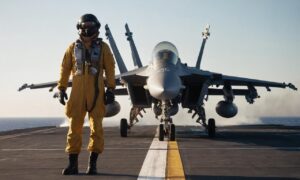When it comes to the complex choreography of aviation, one often-overlooked yet critical aspect is the signaling performed by aircraft marshals. These skilled individuals, often positioned on the tarmac, play a pivotal role in guiding aircraft on the ground. Understanding their signals is essential for pilots and ground crews to ensure the safe and efficient movement of planes in the bustling environment of an airport.
The Basics of Aircraft Marshal Signaling
At first glance, the seemingly intricate hand signals of an aircraft marshal might appear cryptic, but they follow a standardized set of commands. These signals are a non-verbal means of communication between the marshal and the cockpit, where the noise of engines and the distance make verbal communication impractical.
Common signals include the classic ‘come forward’ motion, where the marshal uses a forward-facing open palm, indicating to the pilot to advance. Conversely, a closed fist or a waving motion can instruct the pilot to stop or hold position. Understanding these fundamental signals is crucial for pilots during taxiing, parking, and other ground operations.
Role of Aircraft Marshal in Ground Operations
The responsibilities of an aircraft marshal extend beyond basic signaling. They are responsible for ensuring the aircraft is positioned correctly at the gate, guiding it during pushback, and coordinating with ground crews for various tasks such as refueling and baggage handling. The marshal acts as the eyes and ears on the ground, facilitating smooth communication between the cockpit and ground personnel.
During parking, the marshal not only guides the aircraft into the designated spot but also ensures there is sufficient clearance on all sides. This meticulous process is crucial, especially in congested airports where space is limited, and precision is paramount.
International Standards for Aircraft Marshal Signals
Given the global nature of aviation, standardized signals are imperative for ensuring consistency and safety. The International Civil Aviation Organization (ICAO) provides guidelines for aircraft marshals, establishing a common language for ground operations. Pilots and ground crews worldwide adhere to these standards, promoting a seamless flow of communication regardless of the airline or airport.
It’s worth noting that while there are universal signals, some airports may have specific variations or additional signals based on their unique layouts or operational requirements. Pilots and ground crews undergo rigorous training to familiarize themselves with these variations and ensure a harmonized workflow.
Enhancing Safety and Efficiency
Effective aircraft marshal signaling is not only about preventing collisions but also about optimizing ground operations. In the fast-paced environment of an airport, every second counts. Clear and concise communication between the marshal and the flight deck contributes to the overall efficiency of the turnaround process, minimizing delays and maximizing operational productivity.
Moreover, the role of aircraft marshals becomes even more critical during adverse weather conditions or low-visibility situations. In such cases, their signals guide pilots through challenging conditions, ensuring safe navigation on the ground.
In the intricate dance of aviation, the role of aircraft marshals stands out as a silent yet indispensable element. Their signals not only guide planes safely across the tarmac but also contribute to the overall efficiency of ground operations. As we look to the skies, it’s essential to recognize and appreciate the expertise of these individuals who play a crucial role in ensuring the seamless movement of aircraft on the ground.
Frequently Asked Questions
As we delve into the world of aircraft marshal signaling, it’s common to have questions. Here are some frequently asked questions to provide further insights:
How are Aircraft Marshal Signals Standardized Globally?
The standardization of aircraft marshal signals is overseen by the International Civil Aviation Organization (ICAO). This global body establishes a set of universal signals to ensure consistency and safety in ground operations. However, are there variations at specific airports?
What are the Key Responsibilities of an Aircraft Marshal?
While signaling is a prominent aspect, aircraft marshals have a multifaceted role. They are responsible for gate positioning, guiding during pushback, and coordinating with ground crews. How do these responsibilities contribute to the overall safety and efficiency of airport operations?
How Do Pilots and Ground Crews Learn Aircraft Marshal Signals?
Training plays a pivotal role in familiarizing pilots and ground crews with aircraft marshal signals. How do aviation professionals undergo training to ensure they are well-versed in these non-verbal communication cues? Are there specific challenges faced during the training process?
| ICAO Signal | Meaning |
|---|---|
| Open Palm Forward | Command to advance or come forward. |
| Closed Fist or Waving Motion | Instruction to stop or hold position. |
| Variations | Some airports may have specific variations. How do pilots and ground crews adapt to these variations, and what challenges might they face? |
Technology Advancements in Aircraft Marshaling
Advancements in technology have also impacted aircraft marshaling. Modern airports are incorporating electronic signaling systems and communication devices to enhance efficiency and accuracy. How do these technological advancements complement or supplement traditional hand signals? What are the potential benefits and challenges associated with this transition?
Environmental Considerations in Aircraft Marshaling
Environmental factors, such as adverse weather conditions and low visibility, can significantly impact aircraft marshaling. How do marshals adapt their signals and procedures during challenging weather situations? What precautions are in place to ensure safety and operational continuity in such conditions?






